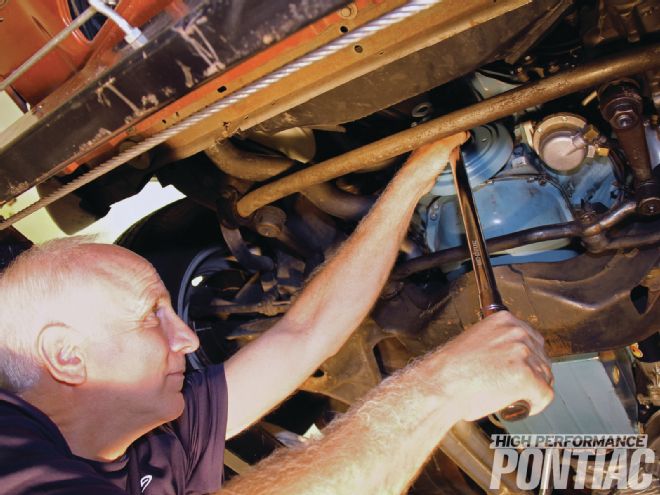
The harmonic damper located on the front of the crankshaft serves a very important purpose. It’s designed to absorb the resonate harmonics that can otherwise lead to crankshaft failure. It’s assembled in such a way that any unpredicted imbalance within the unit can cause engine damage or failure, and those symptoms leading up to that can unknowingly occur with age.
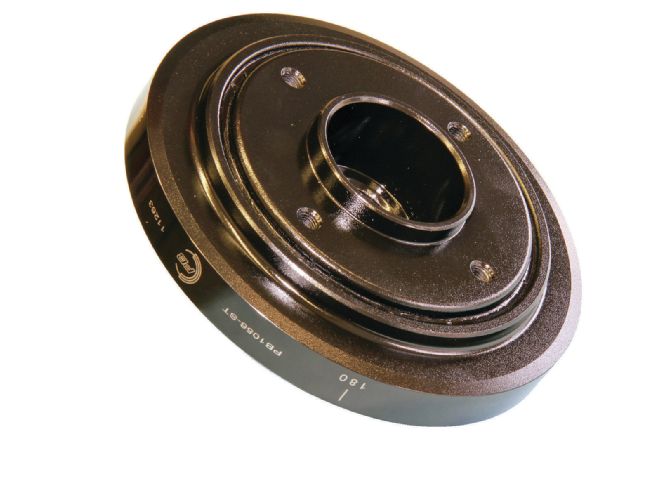 1 Powerbond produces several excellent and affordable harmonic dampers that are direct replacements for the common ’68-later Pontiac unit. Butler Performance sells the stock replacement (PN PBO-PB1056N), which Powerbond suggests for applications up to 400 for $75. PN PBO-PB1056ST (shown here) is ideal for high- performance applications up to 600 hp, and sells for $90. We chose it when seeking to replace our Firebird’s original.
1 Powerbond produces several excellent and affordable harmonic dampers that are direct replacements for the common ’68-later Pontiac unit. Butler Performance sells the stock replacement (PN PBO-PB1056N), which Powerbond suggests for applications up to 400 for $75. PN PBO-PB1056ST (shown here) is ideal for high- performance applications up to 600 hp, and sells for $90. We chose it when seeking to replace our Firebird’s original.
Rather than being reactive when any issues arise, we chose to be proactive, replacing our ’72 Firebird’s original damper with a high-performance stock replacement from Butler Performance, repairing a pesky oil leak in the process. Follow along as we explore the steps involved with installing a new harmonic damper, and have our Firebird back on the road in less than two hours.
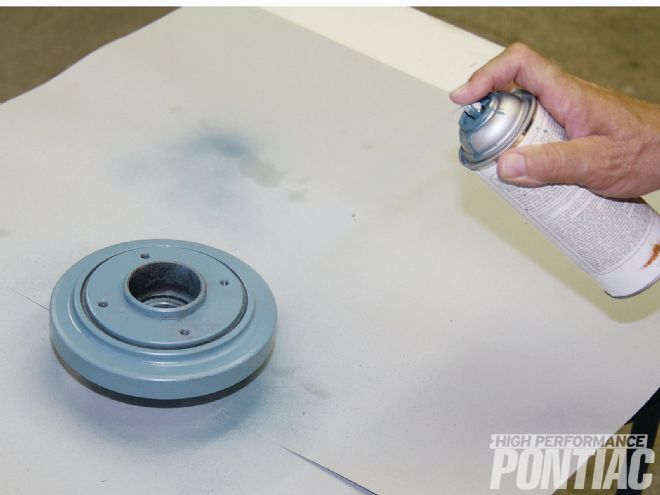 2 Powerbond balancers come with a quality black finish. If original appearance is important to you, however, it can easily be painted in a shade of blue that matches your engine.
2 Powerbond balancers come with a quality black finish. If original appearance is important to you, however, it can easily be painted in a shade of blue that matches your engine.
Harmonic Damper Basics
A crankshaft flexes and twists with each rotation during normal operation. That action creates a torsional vibration, which can eventually cause the crank to fatigue and fail. A large hub fastened to the front crankshaft absorbs harmonic irregularities to prevent crank failure.
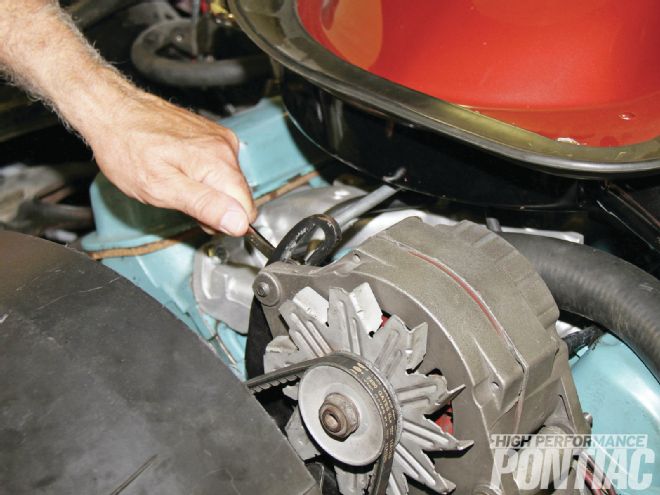 3 Disassembly begins by loosening the accessories with the appropriate wrenches and sockets, and removing their drive belts. The fan and water pump pulley follows, which requires a 1⁄2-inch socket.
3 Disassembly begins by loosening the accessories with the appropriate wrenches and sockets, and removing their drive belts. The fan and water pump pulley follows, which requires a 1⁄2-inch socket.
Pontiac used a multi-piece damper that bolted together through ’67. A new unitized design was introduced for ’68, and it’s likely the most common Pontiac damper found today. It measures 63⁄8 inches in diameter and has an outer ring (or inertia weight) that floats about the hub. The two pieces are isolated by elastomer (rubber), which absorbs the torsional irregularities mentioned previously. It’s keyed to the crankshaft for positive location and is fastened by a large bolt.
The ’68-up Pontiac damper is an excellent design with a history of performing very well in stock applications, and even some mildly modified examples producing 400 hp or more. New dampers were available through Pontiac parts departments until a few years ago. Used units are at least 30 years old, however, and the rubber isolator can deteriorate and/or shrink, allowing the outer ring to rotate. That not only affects spark-timing accuracy, it can affect the damper’s balance, negatively impacting its ability to dampen harmonics.
For many other makes, the hub contains a slight imbalance that is used to finely balance the entire reciprocating assembly, hence the name harmonic balancer. That isn’t always the case with the Pontiac V-8, however. Besides original 265/301 units, Pontiac hubs were neutral balanced, serving no balancing purpose. Vintage Pontiac literature refers to it as a harmonic damper, and for the sake of accuracy in this article, we’ll refer to it as such. Be sure the aftermarket damper you’re considering for your Pontiac is internally balanced unless your engine has been rebuilt and is balanced untraditionally.
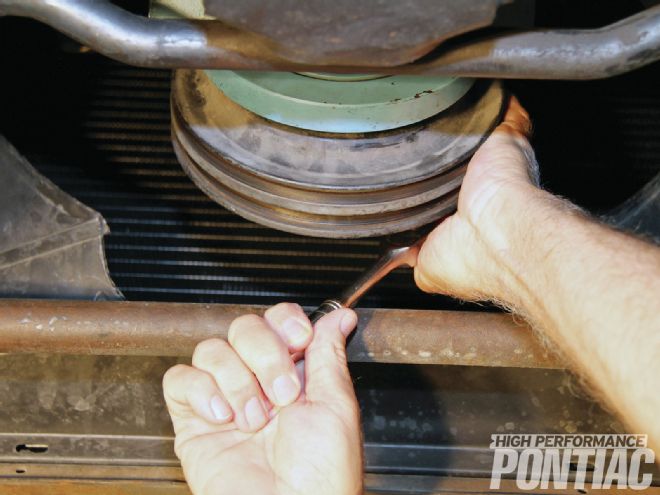 4 Using a 1⁄2-inch socket, the lower pulley (or pulleys if your Pontiac is equipped with A/C) is removed next.
4 Using a 1⁄2-inch socket, the lower pulley (or pulleys if your Pontiac is equipped with A/C) is removed next.
Our Pontiac
A front-crankshaft-seal leak had been little more than a minor annoyance for a few years. It’s a simple repair that we put off for several months, and it happens to require removing the harmonic damper.
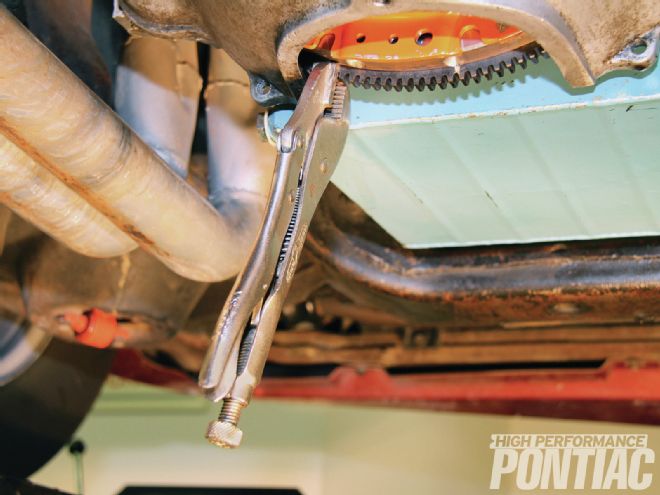 5 The damper bolt is extremely tight and any attempt at removing it will cause the engine to turn over. There are myriad methods for breaking the bolt loose, but securely clamping a pair of locking pliers on the ring gear is the easiest. Simply rotating the engine binds the pliers with the bellhousing, preventing further rotation.
5 The damper bolt is extremely tight and any attempt at removing it will cause the engine to turn over. There are myriad methods for breaking the bolt loose, but securely clamping a pair of locking pliers on the ring gear is the easiest. Simply rotating the engine binds the pliers with the bellhousing, preventing further rotation.
Now, the original damper on our ’72 Firebird is more than 40 years old, but it has presented no operational issues thus far, and looked to be in excellent shape. Past experience tells us that there’s oftentimes no telling when or if the outer ring could slip, eventually causing it to fail, and having the damper off to replace the front seal presented us with the ideal opportunity to install a better one.
Powerbond produces three stock-sized dampers for the Pontiac V-8 that accept all original accessory pulleys—two street dampers, a stock replacement and high-performance unit, and single race damper, which is SFI approved. The dampers are manufactured using a specific process in which rubber is injected onto the hub and outer ring to provide a positive bond that prevents slipping and separating. With its excellent design and great quality, Powerbond’s street dampers are rated to 6,500 rpm and its SFI unit is rated to 12,500 rpm.
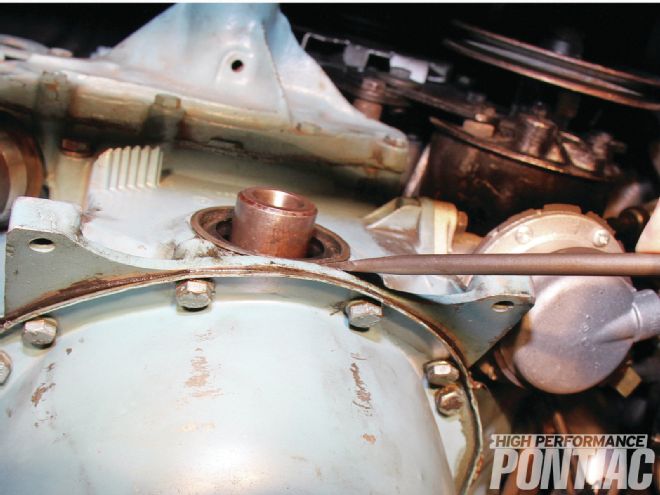 9 The old seal is pried out using a large flat-blade screwdriver. The new seal is carefully tapped into place using a large socket and a hammer. Removal and install takes just a couple of minutes.
9 The old seal is pried out using a large flat-blade screwdriver. The new seal is carefully tapped into place using a large socket and a hammer. Removal and install takes just a couple of minutes.
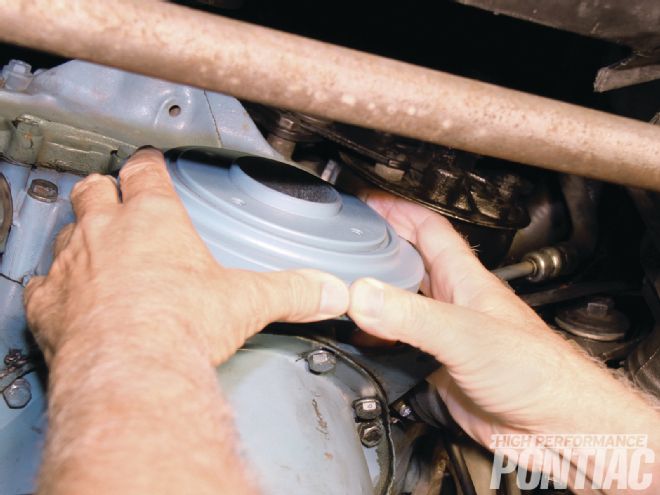 10 The crankshaft snout and seal surface of the new damper are slightly coated with engine oil before being placed on the snout. Simply spin it around until the keyway lines up and slide it completely into place.
10 The crankshaft snout and seal surface of the new damper are slightly coated with engine oil before being placed on the snout. Simply spin it around until the keyway lines up and slide it completely into place.
Butler Performance regularly stocks Powerbond dampers, and its technicians felt that the high-performance street damper would be the best performance value for our 455. Retailing at less than $100, Butler Performance had it on our doorstep in a matter of days.
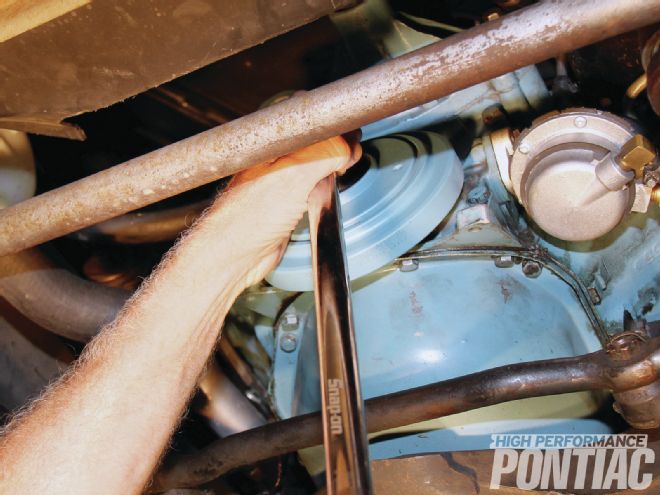 11 If the bolt’s head and threads look to be in excellent shape, there’s no harm reusing the original. It must be tightened to 160 ft-lb using a 15⁄16-inch socket, and installation requires a torque wrench with such capability. We use a high-quality torque wrench with a maximum setting of 250 ft-lb for accurate installation. ARP offers a few different replacement damper bolts if yours needs to be replaced. It suggests its own torque specifications for its bolts.
11 If the bolt’s head and threads look to be in excellent shape, there’s no harm reusing the original. It must be tightened to 160 ft-lb using a 15⁄16-inch socket, and installation requires a torque wrench with such capability. We use a high-quality torque wrench with a maximum setting of 250 ft-lb for accurate installation. ARP offers a few different replacement damper bolts if yours needs to be replaced. It suggests its own torque specifications for its bolts.
Installation was very straightforward. After removing the accessory belts, cooling fan, and lower pulley, the damper was removed, which gained us the access necessary to replace the front seal. With that accomplished, the new damper slid into place, its retaining bolt was torqued appropriately, and the accessory pulleys and belts were reinstalled. It took about 90 minutes to complete the task.
Conclusion
If your Pontiac’s damper is of unknown age or condition, it’s wise to consider replacement upon the next opportunity. Powerbond offers two options that are ideal for most applications. They install quickly and easily, accept all stock hardware, and best of all, can be disguised to prevent detracting from an original underhood appearance.
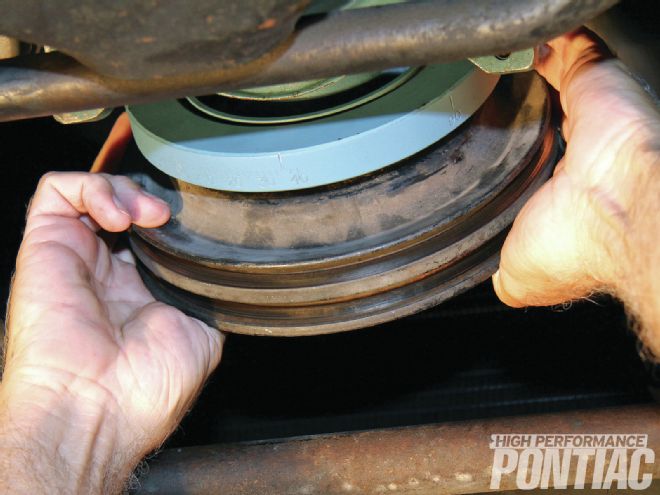 12 The lower pulley is reinstalled and its four retaining bolts are tightened to 20 ft-lb using a 1⁄2-inch socket. Be sure to reinstall the spacer ring between the bolts and pulley. It evenly disperses the fastener load, which can otherwise tear out the bolt holes during normal operation.
12 The lower pulley is reinstalled and its four retaining bolts are tightened to 20 ft-lb using a 1⁄2-inch socket. Be sure to reinstall the spacer ring between the bolts and pulley. It evenly disperses the fastener load, which can otherwise tear out the bolt holes during normal operation.
When you consider that either option costs less than $100, it’s almost foolish to not replace your original!
It’s designed to absorb the resonate harmonics that can otherwise lead to crankshaft failure.